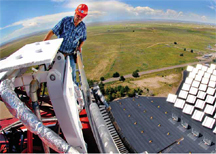
Sandians looking skyward towards the solar tower received a bright surprise in the first week of September. NASA’s dramatic tests produced bright light, smoke, and some flames while conducting materials tests crucial to the next generation of spacecraft.
These tests continue the testing that NASA began last year. NASA’s tests are the first conducted at the top of the solar tower, where NASA contractors built special facilities designed specifically for these experiments.
NASA researchers mounted samples of advanced ablative materials on special arms on top of the solar tower and exposed them to concentrated solar radiation. Researchers tested 12” x 12” samples of an “advanced charring ablator,” pieces of heat shield that NASA hopes to include as part of a new advanced thermal protection system for aerocapture flight maneuvers, a system that NASA officials hope will save on future mission fuel costs.
The tests exposed the ablator samples to solar power levels up to 1,500 watts per square centimeter — approximately 1,500 times the intensity of the sun on Earth on a clear day. This energy simulates the high heat encountered during the aerocapture maneuver’s hypersonic flight through an atmosphere.
Cheryl Ghanbari (6218), test engineer at the solar tower, subjected the shield material to a 3,500 F solar light from the Labs’ Solar Thermal Test Facility onto sample materials.
Cheryl and her team controlled the exposure duration by using preprogrammed heliostat movement, and controlled intensity by the number of heliostats used for each test. They monitored radiation flux, or the intensity of the solar energy, using a radiometer that is exposed before and after each test.
The tests helped determine the overall effectiveness of advanced thermal protection systems, adhesives, and structure combinations for a future rigid aeroshell system.
Aeroshells are protective cases that surround some types of spacecraft. Advanced aeroshell structures and adhesives allow reduced mass for the aeroshell system, allowing more science instruments or smaller launch vehicles.
The aeroshell system and thermal protection system being studied during this series of tests are similar to those developed for past Venus, Mars, Jupiter, and Earth-return missions. In January 2005, a rigid aeroshell system delivered the entry probe Huygens into the atmosphere of Saturn’s largest moon, Titan, as part of a mission jointly conducted by NASA, the European Space Agency, and the Italian space agency, Agenzia Spaziale Italiana.
NASA and its contractors were pleased with the tests. “It’s worked beautifully,” said Bill Congdon, manager of ARA Ablatives Laboratory into his radio after the first set of tests went better than planned. Perfect weather and expert execution allowed them to test more samples than planned. ARA, based in Colorado, makes the materials under contract to NASA. “Our goal in this test was to make sure it didn’t come apart.”
More than 100 similar tests on samples ranging from 5-inch diameter coupons to panels up to 24 inches square have been conducted during the last three years.
Bonnie James, program manager for NASA, says Sandia’s Solar Thermal Test Facility is the only place in the country where NASA can test objects of this size under such intense heat. The project planners had evaluated heat-producing facilities all over the country, including the NASA Ames facility, but determined it was difficult to find facilities that could test things “larger than a coupon,” a much smaller sample than this test required.
“This is a very unique facility with very unique capabilities,” James says.
Note: For a 360-degree, interactive view from the top of the Sandia solar tower during the test, check out Lab News photographer Randy Montoya’s Quicktime VR image here. You’ll need Apple’s latest Quicktime software to view and manipulate the image. It’s available Click here to download Quicktime.